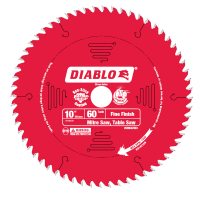 Now that I finally have a shiny new saw, I decided that I started wondering how my old table saw would work if it had a nice new blade on it. Maybe I could get the old blade sharpened, but I kind of just want to start with a new blade and then take care of it properly from the beginning.
Now that I finally have a shiny new saw, I decided that I started wondering how my old table saw would work if it had a nice new blade on it. Maybe I could get the old blade sharpened, but I kind of just want to start with a new blade and then take care of it properly from the beginning.
I started reading about saw blades and WOW, there are a lot of things to know about the blades. There are different diameters, different blade shapes, different angles for the teeth, different numbers of teeth, different thicknesses for the blade and the list goes on. This article from Rockler is one of the best ones I found for summarizing all the info but here is a quick summary of what I learned:
- My table saw and my circular saw use the same diameter blade so I can buy one blade and use it either place.
- Miter saws should generally have a higher tooth count since you are mostly doing cross cuts (~60-80 teeth) while table saw blades should have a lower tooth count since you are mostly doing rip cuts (~24-40 teeth.)
- If you have less than a three horsepower motor, consider using a thin kerf (thickness) blade. The tradeoff is that the blade might deflect more, but since you are removing less wood, your motor can power through the cuts easier. You’re also generating less dust!
- Most saw blades have a positive angle to the teeth meaning that they lean forward. Miter saws benefit from a slightly negative tooth angle. This gives you a more controllable cut and also helps to prevent the saw blade from pulling the back side of your wood up into the air.
The saw blade that came on my miter saw is probably better suited for my table saw so I’m hoping to move that over and then buy a higher tooth count blade for my miter saw.
